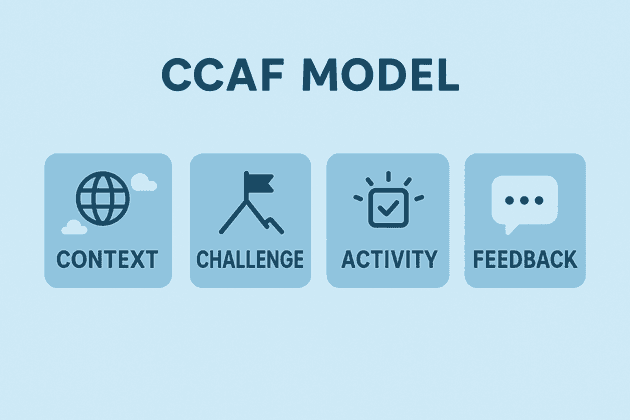The CCAF Instructional Design Model: Engaging and meaningful learning experience requires Context, Challenge, Activity, and Feedback (CCAF).
Have you ever sat through a course or a training session that felt meaningless and time-wasting?
Michael Allen's CCAF model solves this by providing a clear instructional design framework to create a learning-by-doing experience that feels engaging and meaningful.
The CCAF model has four key components: Context, Challenge, Activity, and Feedback.
(1) Context: A meaningful situation.
Context immerses the learner in a relevant scenario right away. Context is used to provide meaning and relevance, and convey that the skills and knowledge have meaning and usefulness in the real world.
For example, for a training lesson about handling customer complaints, you can begin by saying:
"Imagine you're a cashier at a busy store, and an unhappy customer is demanding a refund loudly in front of other customers."
(2) Challenge: A stimulus to act within the context.
A challenge creates immediate tension by placing learners in a simulated scenario that demands action through risk, meaningful consequences, and achievable goals. A challenge is used to engage the learners' emotions, motivating them to engage with intention.
For example, continuing the customer complaints scenario, the challenge could ask learners:
"Decide how you will calm the customer down and address their complaint effectively without escalating the situation."
(3) Activity: An action required to address the challenges.
An activity involves practical, actionable steps learners must take. These actions reflect real-world tasks and enable learners to apply their knowledge practically, both within and beyond the course.
For example, you can provide an interactive simulation where learners practice selecting dialogue options to resolve the customer's complaint, observing immediate responses from the customer based on their choices
(4) Feedback: A reflection of the effectiveness of the action.
Feedback tells learners about their performance quality and highlights what they did correctly and how they can improve.
For example, After the customer interaction simulation, provide feedback that details how effectively the learner handled the scenario and offer specific suggestions from experienced customer service representatives on handling similar real-world complaints.
I found the CCAF framework to be quite useful as a checklist for examining whether others' learning designs are meaningful and motivational.
This framework also reminds me of how a reinforcement learning agent learns.
